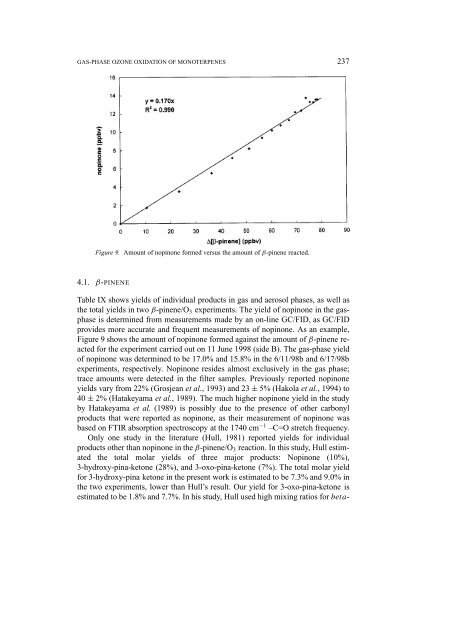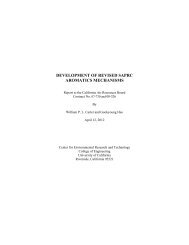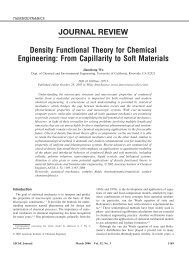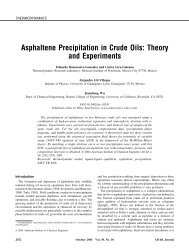Gas-Phase Ozone Oxidation of Monoterpenes: Gaseous and ...
Gas-Phase Ozone Oxidation of Monoterpenes: Gaseous and ...
Gas-Phase Ozone Oxidation of Monoterpenes: Gaseous and ...
Create successful ePaper yourself
Turn your PDF publications into a flip-book with our unique Google optimized e-Paper software.
GAS-PHASE OZONE OXIDATION OF MONOTERPENES 237<br />
Figure 9. Amount <strong>of</strong> nopinone formed versus the amount <strong>of</strong> β-pinene reacted.<br />
4.1. β-PINENE<br />
Table IX shows yields <strong>of</strong> individual products in gas <strong>and</strong> aerosol phases, as well as<br />
the total yields in two β-pinene/O 3 experiments. The yield <strong>of</strong> nopinone in the gasphase<br />
is determined from measurements made by an on-line GC/FID, as GC/FID<br />
provides more accurate <strong>and</strong> frequent measurements <strong>of</strong> nopinone. As an example,<br />
Figure 9 shows the amount <strong>of</strong> nopinone formed against the amount <strong>of</strong> β-pinene reacted<br />
for the experiment carried out on 11 June 1998 (side B). The gas-phase yield<br />
<strong>of</strong> nopinone was determined to be 17.0% <strong>and</strong> 15.8% in the 6/11/98b <strong>and</strong> 6/17/98b<br />
experiments, respectively. Nopinone resides almost exclusively in the gas phase;<br />
trace amounts were detected in the filter samples. Previously reported nopinone<br />
yields vary from 22% (Grosjean et al., 1993) <strong>and</strong> 23 ± 5% (Hakola et al., 1994) to<br />
40 ± 2% (Hatakeyama et al., 1989). The much higher nopinone yield in the study<br />
by Hatakeyama et al. (1989) is possibly due to the presence <strong>of</strong> other carbonyl<br />
products that were reported as nopinone, as their measurement <strong>of</strong> nopinone was<br />
based on FTIR absorption spectroscopy at the 1740 cm −1 –C=O stretch frequency.<br />
Only one study in the literature (Hull, 1981) reported yields for individual<br />
products other than nopinone in the β-pinene/O 3 reaction. In this study, Hull estimated<br />
the total molar yields <strong>of</strong> three major products: Nopinone (10%),<br />
3-hydroxy-pina-ketone (28%), <strong>and</strong> 3-oxo-pina-ketone (7%). The total molar yield<br />
for 3-hydroxy-pina ketone in the present work is estimated to be 7.3% <strong>and</strong> 9.0% in<br />
the two experiments, lower than Hull’s result. Our yield for 3-oxo-pina-ketone is<br />
estimated to be 1.8% <strong>and</strong> 7.7%. In his study, Hull used high mixing ratios for beta-
















